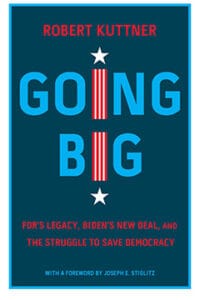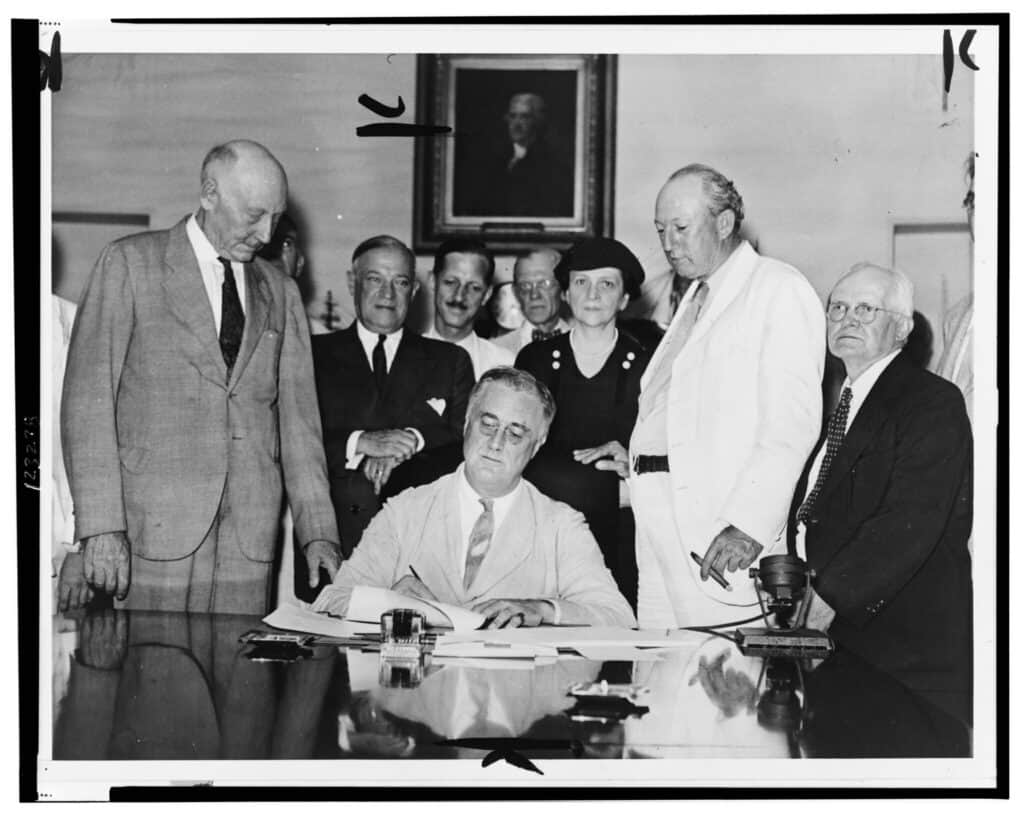Summary
When a key crafter of the Community Reinvestment Act speaks, it behooves us all to listen.
Going Big: FDR’s Legacy, Biden’s New Deal and the Struggle to Save Democracy is a playbook for Democratic candidates and presidents, filled with astute observations about the political advantages and economic rationales of New Deal-style government programs. It is an exhortation for modern leaders to adopt those venerated ideas in full – not mere retreads or watered-down versions of them. I agree that it is a winning formula.
Kuttner is a fixture in liberal/left journalism. He is the co-founder of the American Prospect and the author of more than a dozen books. He also was one of the founders of Economic Policy Institute, a pro labor think tank.
But Kuttner’s role in creating the Community Reinvestment Act (CRA) is less well-known, which NCRC sought to address by presenting an award to Kuttner at our 2009 annual conference.
Kuttner was among the drafters of CRA while on staff with the Senate Banking Committee when Senator William Proxmire marshaled CRA successfully through Congress. Kuttner personally inserted the phrasing that banks must serve their communities with ‘safe and sound’ loans. This one phrase has been significantly responsible for CRA’s survival over four tumultuous decades: Critics ultimately cannot charge that CRA promotes risky lending since the law stipulates safe and sound lending. Given his prescience in building a suit of legislative armor for CRA, when Kuttner writes about economic policy, it behooves us to listen.
Kuttner’s thinking centers upon empowering people to think and act from mutual interest in local ways. Within this intellectual framework, he has devoted his policy analysis to two areas of life: where people work, and where people live. Going Big reflects this point of view in its recounting of the past century of US economic and political history: Kuttner’s attention focuses heavily upon policies that shaped labor rights and neighborhood development.
The New Deal dramatically increased economic productivity and wages by employing a people first approach. By massively increasing public investment in infrastructure, the New Deal refurbished a deteriorating transportation system, which literally sped up commerce. At the same time, labor law reforms such as the Wagner Act that established the right for workers to unionize enabled workers to bargain for higher wages. With improvements in wages and labor conditions, employees worked harder and were more satisfied and productive on the job.
Towards the middle of the book, Kuttner reproduces a well known chart (at least for policy wonks) showing tremendous increases in economic productivity and wages from the 1940s through 1973. After 1973, the line showing productivity climbs steeply while the line showing wages stagnates. Kuttner described various economic theories for this divergence including the increase in low-paid service work after 1973. He maintained, however, that the “main cause was the destruction of the social contract that had prevailed since the New Deal, in which capital was well regulated, labor was empowered, and government intervened on behalf of the common man and woman.”

Unionization rates declined from approximately 30% in the 1960s to about 10% today – and Kuttner details how policy choices drove that collapse. The federal government aided and abetted union busting, starting when President Reagan busted the air traffic controllers union in the 1980s. In addition to overt union busting by the federal government, Kuttner also discusses in illuminating detail the Federal Reserve’s blunt inflation busting under then-Chairman Paul Volker in the late 1970s and early 1980s. Kuttner lists alternative approaches to the “stagflation” crisis that helped boost Reagan to power – alternatives that would not have caused high unemployment rates and further depressed unionization. The scars of Volker’s and Reagan’s actions are still visible in today’s economy. Only in the last few years has the nation experienced a well-publicized increase in unionization drives, which still confront monumental odds including difficulties negotiating the first contract after a successful vote certifying unions at Amazon plants, Starbucks cafes and other establishments.
As well as empowering workers, policy should empower communities. A guiding principle of public policy should be that community residents, as victims of discrimination, should have rights and opportunities to provide input into bank programs and products as well as oversight of financial regulatory agencies. Invigorating CRA creates vibrant neighborhoods with thriving economies by tapping into the insights of community residents. Kuttner does not discuss CRA much, perhaps because his book reviewed the economic programs and policies of several Presidents from FDR through Obama, none of whom embraced CRA as a central policy of their administrations. Hopefully, NCRC and the economic justice movement can propel CRA into the economic platform of a future President.
Regulatory oversight of various industries was also a key feature of New Deal policies. While the oversight of the financial industry and the creation of the Securities and Exchange Commission and the Federal Deposit Insurance Corporation is the most well-known aspect of New Deal regulation, Kuttner also described the New Deal regulation of airlines, trucking, electricity and public utilities. He stated that his 1996 book, Everything for Sale, found that innovation and efficiency was greater in these industries while they were regulated as opposed to when the government deregulated them.
The area of deregulation that NCRC’s constituencies are most familiar with is the financial industry. Starting in the 1970s, Congress and Presidential administrations loosened the New Deal regulation of the financial industry. This eventually created a wild west of “shadow banking” or the unregulated part of the financial industry that peddled abusive subprime loans to consumers and then sold them to unsuspecting investors. There were laws on the books to curtail this predatory activity, but they were not strong enough. The enforcer of these laws, then-Federal Reserve Chairman Alan Greenspan, decided to take a hands off approach.
The result is sadly familiar – the loss, in the 2008 housing market crash, of at least $7 trillion of home equity and an epidemic of home foreclosures that disproportionately impacted homeowners of color and modest income communities. The Dodd-Frank Wall Street Reform and Consumer Protection Act of 2010 strengthened anti-predatory lending laws in part by implementing the maxim that lenders must not offer loans that borrowers cannot afford to repay. But despite such legislative successes, Kuttner correctly writes, the Obama Administration veered from the New Deal playbook by doing a good job making bankers whole without offering enough assistance to foreclosure victims.
An informative but alarming discussion along the deregulation theme concerns private equity. Private equity companies acquire non-financial companies, including retailers and newspapers, and load them up with debt, often precipitating their bankruptcy. In desperate attempts to save their companies, management often slash costs and wages. Kuttner maintained, “the parasitic private equity firm or investment banker makes money even if the enterprise fails. Indeed, in the case of private equity, the entire business strategy of the private equity firm of piling on debt and extracting fees and assets increases the risk that the enterprise will fail.” The fight against deregulation continues because unregulated parasitic activity increases misery and inequality, and disempowers communities.
Contrary to the views of mainstream, neoclassical economists, a robust dose of regulation, public investment, social safety nets and empowering the citizenry to be participants in economic and political decisions are prerequisites for a well-functioning and equitable economy and society. Kuttner provides us an invaluable service in building a case for this perspective over decades of work.
Josh Silver is a Senior Fellow at NCRC.
Photo courtesy of Library of Congress via Flickr.



